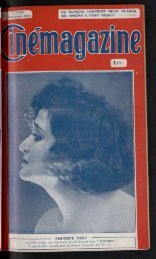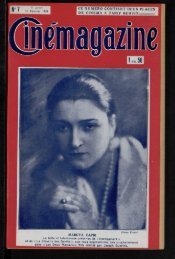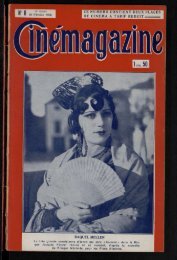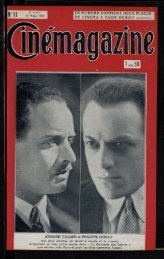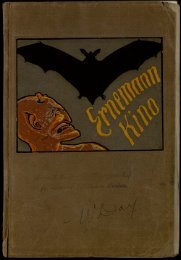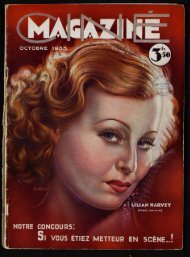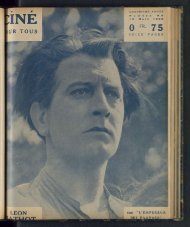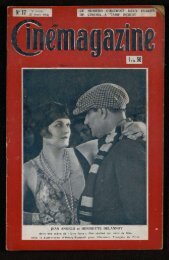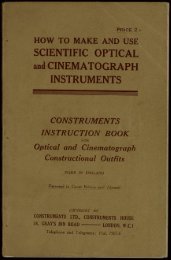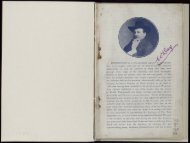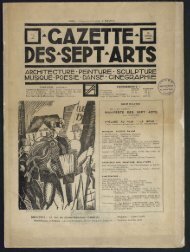Untitled
Untitled
Untitled
Create successful ePaper yourself
Turn your PDF publications into a flip-book with our unique Google optimized e-Paper software.
56 MODERN MAGIC LANTERNS.<br />
wood of the carrier, the first slide is in the centre of the<br />
opening In some forms the grooves are bigger, and a frame<br />
holding two slides can be pushed backwards and forwards<br />
as shown in Fig. 46. This has the drawback that the slides<br />
are inserted and taken out from alternate sides of the lantern.<br />
In the simpler pattern the slides are put in at one<br />
side and taken out<br />
at the other, a more<br />
convenient method,<br />
but still not so good<br />
as one by which they<br />
are manipulated entirely<br />
from one side.<br />
Fig. 46. A SLIDE CARRIER.<br />
This is the case<br />
with the Eclipse<br />
carrier, one of the most ingenious devices of the many which<br />
lanternists owe to Mr. R. R. Beard. The Eclipse carrier, which<br />
is shown in Fig. 47, consists of a frame with a brass runner<br />
carrying the slide. The runner being pulled out, the slide<br />
is put on it and pushed into the lantern, after which the runner<br />
Fig. 47. 1HE ECLIPSE CARRIER.<br />
is again withdrawn and a second slide inserted. On pushing<br />
this into position, it is superimposed on the first, so that the<br />
two pictures are seen mixed up on the screen, the first being<br />
withdrawn on pulling the runner out once more to put the<br />
next slide in, when the second springs up into the exact<br />
position occupied by the first, with a little click. The means<br />
THE LANTERN BODY. 57<br />
by which this is effected is extremely simple, and the only<br />
drawback the carrier possesses is one in common more or<br />
less with all othersthat it does not deal well with slides<br />
which vary much in thickness. This difficulty has been surmounted<br />
in one form of the carrier shown in Fig. 45, by the<br />
introduction of two springs which keep the slides pressed up<br />
against one side of the groove, and so prevent one slide overlapping<br />
the other when pushed through, the grooves being<br />
made sufficiently wide to accommodate the thickest glass<br />
likely to be met with ; this is due to Mr. Chadwick.<br />
Other forms of carrier are those in which the slides are<br />
actuated by a tape travelling over pulleys ; those having a<br />
shutter which cuts off all light while changing a slide ; a<br />
third variety made by Messrs. Archer, of Liverpool, has a<br />
screen of matt celluloid by which the picture is partially<br />
obscured during changing, which is done by one movement<br />
of a lever.<br />
A carrier, although apparently a simple and unimportant<br />
part of the lantern outfit, is, as regards the smoothness and<br />
success of an exhibition, one of the most vital spots. A case<br />
occurs to me where the regularity of a display was ruined<br />
while the operator was engaged in extracting a slide stuck<br />
in the carrier in consequence of a piece of its binding having<br />
become loosened. In the presence of an audience such<br />
a mishap should be impossible, the slides should pass<br />
through in an even and unbroken succession. To secure<br />
this, nothing is so effectual as the simple push-through<br />
carrier, shown in Fig. 45, provided it has springs as mentioned,<br />
and provided that the groove at the bottom is just<br />
so deep that the centre of a 3,1 x 31 slide comes in the centre<br />
of the opening, the top groove being fully one-eighth deeper<br />
than this. When this is the case, slides of varying thickness<br />
and height can be passed through without any overlapping,<br />
and without the smaller slides falling backward or<br />
forward or the bigger ones jamming.<br />
A point generally neglected, but in the case of a public<br />
display a great safeguard against accident, is the provision of<br />
some arrangement by which the slide in the carrier, just<br />
before it is passed into the lantern, can be seen, so that the<br />
Dperator may be able to tell by a glance whether it is in the



